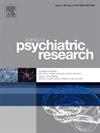基于卷积神经网络的面部表情分析对未用药和慢性精神分裂症的影响。
IF 3.7
2区 医学
Q1 PSYCHIATRY
引用次数: 0
摘要
目的:面部图像已被证明可以作为临床症状传达精神状况。本研究旨在利用面部图像检测健康对照(hc)中未受药物刺激的精神分裂症(DN-SCZ)或慢性精神分裂症(C-SCZ)患者,并探讨这3组患者面部表情的差异,以及面部表情与精神症状的关系。方法:我们招募了45例DN-SCZ患者、106例C-SCZ患者和101例hc患者进行研究,并通过固定的实验范式对他们的面部表情进行录像。将视频数据转换为面部图像,分为两组:一组用于训练以DN-SCZ患者、C-SCZ患者和HC分类为输出的组分类-卷积神经网络(CNN),另一组用于评估组分类-CNN的分类结果。随后,我们对每个基本面部表情提取和评估了300张标记的面部图像。这些标记的图像被用来训练每个组(DN-SCZ, C-SCZ和hc)的单独面部表情cnn。然后,视频中的所有面部图像都通过他们的面部表情cnn进行处理,以输出最可能的面部表情。采用阳性和阴性综合征量表评估精神症状。对预测面部表情进行统计分析,以确定组间差异,并检验预测面部表情与DN/C-SCZ患者临床资料之间的关系。结果:群体分类- cnn基于人脸图像对参与者的正确分类准确率达到90.99%。3种面部表情- cnn对3组8种基本面部表情的预测准确率分别为95.95%、87.23%和92.11%。与DN/C-SCZ患者相比,hc患者的面部图像在效价、唤醒和吸引力方面得分较高,但与正常面部的偏差较低。DN-SCZ患者的快乐图像在效价和唤醒上的评分低于C-SCZ患者,而他们的愤怒图像在唤醒、吸引力和偏离正常图像上的评分高于C-SCZ患者。在固定的实验范式下,DN-SCZ患者表现出悲伤、惊讶的表情,而表现出较少的快乐、愤怒和厌恶的表情,他们的恐惧和愤怒表情的统计指标分别与他们的阳性症状总分和一般精神病理学总分相关。C-SCZ患者表现出更快乐、满足、愤怒和中性的表情,而惊讶的表情较少,面部表情与临床数据无显著关系。结论:面部表情可作为诊断DN-SCZ和C-SCZ患者的指示性体征。三组在某些面部表情上存在客观差异,DN-SCZ患者的某些面部表情与其某些精神症状相关。本文章由计算机程序翻译,如有差异,请以英文原文为准。
Facial expression analysis using convolutional neural network for drug-naive and chronic schizophrenia
Objective
Facial images have been shown to convey mental conditions as clinical symptoms. This study aimed to use facial images to detect patients with drug-naive schizophrenia (DN-SCZ) or chronic schizophrenia (C-SCZ) from healthy controls (HCs), and to investigate differences in facial expressions among these 3 groups, as well as relationships between facial expressions and psychiatric symptoms.
Methods
We recruited 45 DN-SCZ patients, 106 C-SCZ patients and 101 HCs for the study, and videotaped their facial expressions through a fixed experimental paradigm. The video data was converted to facial images and divided into two sets: one for training a group classification-convolutional neural network (CNN) with the classification of DN-SCZ patient, C-SCZ patient and HC as output, and the other for evaluating classification results of the group classification-CNN. Subsequently, we extracted and evaluated 300 labeled facial images for each basic facial expression. These labeled images were employed to train separate facial expression-CNNs for each group (DN-SCZ, C-SCZ, and HCs). All facial images from the videos were then processed by their facial expression-CNNs to output the most probable facial expressions. The psychiatric symptoms were assessed using the Positive and Negative Syndrome Scale. Statistical analyses were conducted on the predicted facial expressions to identify differences among the groups, and to examine relationships between the predicted facial expressions and the clinical data of DN/C-SCZ patients.
Results
The group classification-CNN achieved an accuracy of 90.99% in correctly classifying participants based on facial images. The 3 facial expression-CNNs achieved accuracies of 95.95%, 87.23%, and 92.11% in predicting 8 basic facial expressions within the 3 groups. Facial images of HCs were rated higher in valence, arousal and attractiveness, but lower in deviation from normal face than those of DN/C-SCZ patients. Happy images of DN-SCZ patients were rated lower in valence and arousal than those of C-SCZ patients, while their angry images were rated higher in arousal, attractiveness and deviation from normal images than those of C-SCZ patients. Within the fixed experimental paradigm, DN-SCZ patients exhibited sadder, more surprised expressions, while displaying fewer happy, angry and disgusted expressions, statistical metrics of their fearful and angry expressions were correlated with their total positive symptom score and total general psychopathology score, respectively. C-SCZ patients exhibited happier, more content, angry and neutral expressions, while showing fewer surprised expressions, no significant relationships were observed between their facial expressions and clinical data.
Conclusions
Facial expressions can potentially serve as indicative signs for detecting DN-SCZ and C-SCZ patients. There are objective differences in certain facial expressions among the 3 groups, and certain facial expressions in DN-SCZ patients are associated with some of their psychiatric symptoms.
求助全文
通过发布文献求助,成功后即可免费获取论文全文。
去求助
来源期刊

Journal of psychiatric research
医学-精神病学
CiteScore
7.30
自引率
2.10%
发文量
622
审稿时长
130 days
期刊介绍:
Founded in 1961 to report on the latest work in psychiatry and cognate disciplines, the Journal of Psychiatric Research is dedicated to innovative and timely studies of four important areas of research:
(1) clinical studies of all disciplines relating to psychiatric illness, as well as normal human behaviour, including biochemical, physiological, genetic, environmental, social, psychological and epidemiological factors;
(2) basic studies pertaining to psychiatry in such fields as neuropsychopharmacology, neuroendocrinology, electrophysiology, genetics, experimental psychology and epidemiology;
(3) the growing application of clinical laboratory techniques in psychiatry, including imagery and spectroscopy of the brain, molecular biology and computer sciences;
 求助内容:
求助内容: 应助结果提醒方式:
应助结果提醒方式:


